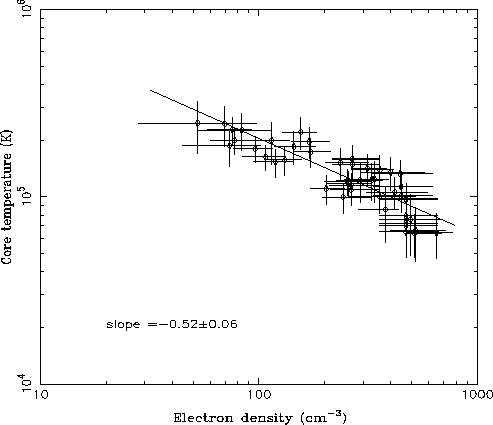Let us study the relation between ![]() and
and ![]() . We only
consider the region from +15 to
. We only
consider the region from +15 to ![]() centrifugal latitude, where
the
centrifugal latitude, where
the ![]() and
and ![]() measurements are independent and the uncertainties
rather small. Fig. 2 shows the data plotted as temperature
versus density in a log-log format, and the associated best-fit
line. Since it would be inadequate to determine the slope from a classical
linear least-squares fitting, because of the finite errors bars on
both
measurements are independent and the uncertainties
rather small. Fig. 2 shows the data plotted as temperature
versus density in a log-log format, and the associated best-fit
line. Since it would be inadequate to determine the slope from a classical
linear least-squares fitting, because of the finite errors bars on
both ![]() and
and ![]() , we used a standard (non-linear) approach taking
into account the uncertainties on both variables ([Press et al. 1992]); to calculate the
, we used a standard (non-linear) approach taking
into account the uncertainties on both variables ([Press et al. 1992]); to calculate the ![]() merit function,
the square deviations between measurements and model are weighted
by
merit function,
the square deviations between measurements and model are weighted
by ![]() , where
, where ![]() and
and ![]() are the measurement
uncertainties and
are the measurement
uncertainties and ![]() the slope to
be determined,
in log-log coordinates. This yields the polytrope relation
the slope to
be determined,
in log-log coordinates. This yields the polytrope relation
with ![]() (3
(3 ![]() ).
).
The correlation coefficient between ![]() and
and ![]() is r =
-0.87.
Given the number of data points (46), the level of significance
of that anticorrelation is very high.
is r =
-0.87.
Given the number of data points (46), the level of significance
of that anticorrelation is very high.

Figure 2: Electron parameters measured in situ aboard
Ulysses, plotted as temperature versus density, and the associated best-fit
line. The data span ![]() in latitudinal distance. (The longitude
varies by
in latitudinal distance. (The longitude
varies by ![]() , centered near
, centered near ![]() , and
the Jovicentric distance only varies from 7.1 to 8.4
, and
the Jovicentric distance only varies from 7.1 to 8.4 ![]() . We have used the
data plotted with solid error bars in Fig.1, which are independent
measurements of
. We have used the
data plotted with solid error bars in Fig.1, which are independent
measurements of ![]() and
and ![]() .)
.)